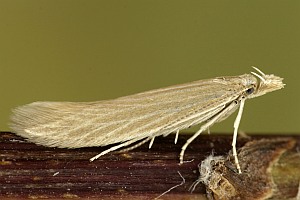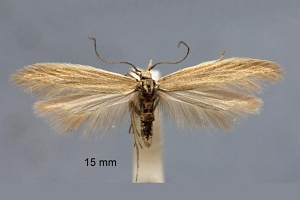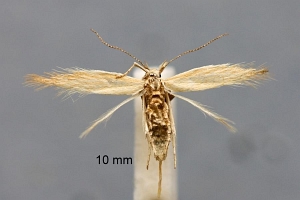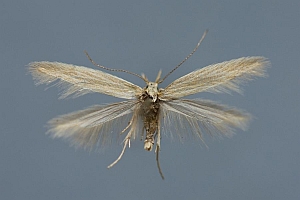

 +19Kontinente:EUAS
+19Kontinente:EUAS2. Diagnose
2.1. Männchen
2.2. Weibchen
2.3. Genitalien
2.3.1. Männchen
2.4. Erstbeschreibung
3. Biologie
3.1. Nahrung der Raupe
- [Poaceae:] Poa trivialis ? (Gewöhnliches Rispengras, Gemeines Rispengras ?)
Vermutlich leben alle Arten der Gattung Megacraspedus als Raupe in Stängeln (oder auch Wurzeln ?) von Süßgräsern (Poaceae). Konkrete Daten dazu fehlen aber fast vollständig.
Huemer & Karsholt (2018) fassen zusammen: "Chrétien (1924: 66–67) bred M. dolosellus from eggs. He placed some females in a container where he had planted Poa annua L., Lolium perenne L., and Trifolium repens L. The females placed their eggs in the leaf sheaths of the grasses or between stipules of the leaves and the stems of T. repens. The larvae hatched within 10–12 days, and the young larva descends to the base of the stems of the grasses. It bores into the stem and occupies a small space, depositing its frass inside the stem. Chrétien (op. cit.) did not explicitly write that larvae of M. dolosellus feed within stems or roots of Trifolium, and that plant is unlikely as a host for a Megacraspedus species, but he also recorded that he bred M. dolosellus from roots of Poa trivialis L."
4. Weitere Informationen
4.1. Andere Kombinationen
- Ypsolophus dolosellus Zeller, 1839 [Originalkombination]
4.2. Synonyme
- Ypsolophus separatellus Fischer von Röslerstamm, 1843 [K.+R.-Nr. 03201] [synonymisiert durch Huemer & Karsholt (2018)]
- Megacraspedus separatellus (Fischer von Röslerstamm, 1843) [synonymisiert durch Huemer & Karsholt (2018)]
- Megacraspedus incertellus Rebel, 1930 [K.+R.-Nr. 03206] [synonymisiert durch Huemer & Karsholt (2018)]
4.3. Taxonomie und Faunistik
Megacraspedus dolosellus und M. separatellus sind beide aus der Umgebung von Wien beschrieben worden. Huemer & Karsholt (2018) stellen fest: "The correct identification of males of M. dolosellus and M. separatellus was always considered to be an extremely difficult task as both taxa were considered as hardly separable in the male sex (Kasy 1987: 13). In contrast the two female morphotypes with longer lanceolate (form dolosellus) or short and pointed (form separatellus) hindwings were widely accepted as diagnostic for species identification by Kasy (op. cit.) and other authors. However, additional females from Russia (Altai mts) show intermediate characters with a tendency to individual infrasubspecific variation." Die von früheren Autoren genannten äußeren Merkmale der Falter werden von den Autoren überprüft und - mit guten Argumenten - allesamt in Frage gestellt. Die morphologischen Merkmale sind also in beiden Geschlechtern kaum geeignet, die beiden Taxa zu trennen.
Und was sagt die Genetik? Die Autoren nahmen auch das in Angriff: "We therefore cross-checked genetic divergence in both female morphotypes. Sequences of three morphologically identified females of M. dolosellus exhibit a considerable intraspecific divergence of mean 1.2% and maximum 1.9% with a barcode gap of 4.9% to M. separatellus. The intraspecific barcode divergence in two sequenced females of M. separatellus is even more pronounced at 2.3%." Es gibt also - vielleicht - Unterschiede zwischen den Taxa. Aber wenn schon bei so wenigen Exemplaren eine so riesige intraspezifische Divergenz besteht, wird auch eine Barcode-Lücke von 4,9 % nicht zu einem zuverlässigen Trennungsmerkmal. Es wird noch schlimmer, wenn man auch Männchen und insgesamt mehr Tiere zur Untersuchung heranzieht! Huemer & Karsholt (2018) mussten feststellen: "The extraordinary DNA barcode divergence is reflected by 23 BINs! The intraspecific divergence of the barcode region in this species is mean 7.5% and maximum 13.8%, largely reflecting a geographic pattern. However, on several occasions large intrapopulational divergence was detected, e.g., in specimens from Italy (Gran Sasso), Bulgaria (Pirin Mts Blagoewgrad), Montenegro (Durmitor), and Slovakia with two sympatric clusters in each region. Individual variation of specimens collected at the same time in the same microhabitat may be high in these cases as e.g., in clusters dolo03 and dolo04 with two specimens diverging 6.9% in DNA barcode." Entweder wir haben da zwei Dutzend oder noch mehr Arten - oder aber nur eine einzige.
Huemer & Karsholt (2018) führen daher M. separatellus und auch das aus Süd-Bulgarien (locus typicus nach Rebel (1930: (14)): Alibotuschgebirge, 1600-1700 m - auch später ohne weitere Fundorte) beschriebene Taxon Megacraspedus incertellus als "syn. n." von M. dolosellus. Dies ist gut nachvollziehbar. Sie erläutern: "Considering the observed intrapopulational barcode variation of nearly 8% we conclude that M. dolosellus is as a widespread species, ranging from Eastern Europe to Central Asia. The exceptional DNA barcode divergence may be explained by weak dispersal ability, particularly of the strongly brachypterous females, leading to several genetically isolated populations. However, it seems unlikely that this is the sole cause for the observed intraspecific variation (see Discussion)."
(Autor: Erwin Rennwald)
4.4. Typenmaterial
Huemer & Karsholt (2001: 239): “''Lectotype'' ♂ (here designated): ‘dolosella FR Wien’ ‘Ypsolophus dolosellus Zeller Isis p 190 (1839) TYPE ♂’ ‘Zeller Coll. Wlsm. Coll. B.M. 1910-427.’ ‘Lectotypus ♂ Ypsolophus dolosellus Select. K. Sattler, 1961’ ‘B.M. Genitalia slide No. 7201 ?’ ‘Type’ ‘LECTOTYPE’ (BMNH).”
4.5. Literatur
- Chrétien, P. (1924): Une localité en perdition – La plaine de Nanterre. — L’Amateur de Papillons, 2: 5–11, 17–22, 33–38, 49–53, 65–69. [Sekundärzitat]
- Beschreibung als Ypsolophus separatellus: Fischer von Röslerstamm, J. E. (1834-1843): Abbildungen zur Berichtigung und Ergänzung der Schmetterlingskunde, besonders der Microlepidopterologie als Supplement zu Treitschke`s und Hübner`s europaeischen Schmetterlingen, mit erläuterndem Text. 1-304, [i]-[iv], pl. 1-100. Leipzig (Hinrichs). — Digitalisat von Google Books im Viewer der Hathi Trust Digital Library: [302], [pl. 100].
- Lectotypus-Festlegung: Huemer, P. & O. Karsholt (2001): Megacraspedus eburnellus sp. nov. and M. dolosellus (Zeller, 1839), a case of confusion in alpine lepidopterology (Lepidoptera: Gelechiidae). — Entomologische Zeitschrift 111 (8): 238-242. Ex libris Jürgen Rodeland.
- Huemer, P. & O. Karsholt (2018): Revision of the genus Megacraspedus Zeller, 1839, a challenging taxonomic tightrope of species delimitation (Lepidoptera, Gelechiidae). — Zookeys 800: 1-278. [https://doi.org/10.3897/zookeys.800.26292] (29 Nov 2018) [Open-access-Artikel auf zookeys.pensoft.net]
- Nel, J. & T. Varenne (2019): A propos des femelles de cinq espèces françaises du genre Megacraspedus Zeller, 1839 (Lepidoptera, Gelechiidae). — Revue de l'Association Roussillonnaise d'Entomologie 28 (2): 110-115.
- Beschreibung als Megacraspedus incertellus: Rebel, H. (1930): Neue Lepidopteren aus Bulgarien. — Verhandlungen der Zoologisch-Botanischen Gesellschaft in Wien 80: (12)-(15). [PDF auf zobodat.at]
- Šumpich, J. (2022): Megacraspedus (Lepidoptera: Gelechiidae) of the Altai Mountains with description of a new species belonging to the M. majorella group. — Acta entomologica musei nationalis Pragae 62 (2): 401-409. [PDF auf www.aemnp.eu]
- Erstbeschreibung: Zeller, P. C. (1839): Versuch einer naturgemäßen Eintheilung der Schaben. — Isis von Oken 1839 (3): 167-220. Leipzig (Brockhaus).

























